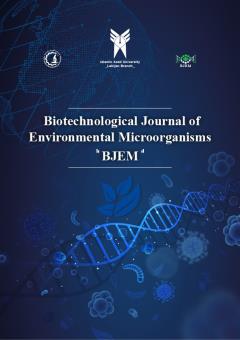Life in the Hidden Atmosphere: Culturing and Genomic Perspectives on Aerobiology in Gypsum Caves
محورهای موضوعی : Biotechnological Journal of Environmental Microorganisms
1 - Department of Microbiology, SR.C., Islamic Azad University, Tehran, Iran
کلید واژه: aerobiology, gypsum caves, next-generation sequencing (NGS), culturing methods, cave microbiome, environmental zonation, microclimate,
چکیده مقاله :
Aerobiology, the study of airborne microorganisms and particles, provides a crucial lens through which subterranean ecosystems can be understood. In gypsum caves unique low-energy environments with potent microclimatic gradients—the airborne microbiome reflects a dynamic interaction between geology, ventilation, and biological processes. Traditional culture-dependent studies have characterized primarily spore-forming and resilient taxa, whereas next-generation sequencing (NGS) technologies now uncover the enormous hidden diversity of both culturable and non-culturable microorganisms suspended in cave air. This review synthesizes ongoing knowledge on aerobiology and environmental zonation in gypsum caves, with emphasis on the comparative performance of culturing and NGS approaches. It examines methodological advances, ecological implications, and the role of bioclimatic parameters temperature, relative humidity, CO₂, and CH₄ concentrations in shaping microbial dispersion and persistence. Integrating molecular biology with microclimate monitoring not only broadens the understanding of cave aerobiomes but also informs conservation strategies for fragile subterranean habitats increasingly affected by tourism and climate change.
Aerobiology, the study of airborne microorganisms and particles, provides a crucial lens through which subterranean ecosystems can be understood. In gypsum caves unique low-energy environments with potent microclimatic gradients—the airborne microbiome reflects a dynamic interaction between geology, ventilation, and biological processes. Traditional culture-dependent studies have characterized primarily spore-forming and resilient taxa, whereas next-generation sequencing (NGS) technologies now uncover the enormous hidden diversity of both culturable and non-culturable microorganisms suspended in cave air. This review synthesizes ongoing knowledge on aerobiology and environmental zonation in gypsum caves, with emphasis on the comparative performance of culturing and NGS approaches. It examines methodological advances, ecological implications, and the role of bioclimatic parameters temperature, relative humidity, CO₂, and CH₄ concentrations in shaping microbial dispersion and persistence. Integrating molecular biology with microclimate monitoring not only broadens the understanding of cave aerobiomes but also informs conservation strategies for fragile subterranean habitats increasingly affected by tourism and climate change.
Barton, H. A., & Jurado, V. (2007). What's up down there? Microbial diversity in caves.
Bontemps, Z., Moënne-Loccoz, Y., & Hugoni, M. (2024). Contributions of DNA sequencing technologies to the integrative monitoring of karstic caves. Applied Sciences, 14(20), 9438.
Buursink, M. Geochemistry and Characterization of Geologic Methane and Carbon Dioxide Sources in Southern California. AAPG Pacific Section Convention, 2020 Vision: Producing the Future:,
C. Gaylarde, C. (2020). Influence of environment on microbial colonization of historic stone buildings with emphasis on cyanobacteria. Heritage, 3(4), 1469-1482.
Calaforra, J. M., & Pulido-Bosch, A. (1996). Some examples of gypsum karsts and the more important gypsum caves in Spain. International Journal of Speleology, 25(3-4), 225-237.
de Groot, G. A., Geisen, S., Wubs, E. J., Meulenbroek, L., Laros, I., Snoek, L. B., Lammertsma, D. R., Hansen, L. H., & Slim, P. A. (2021). The aerobiome uncovered: Multi-marker metabarcoding reveals potential drivers of turn-over in the full microbial community in the air. Environment International, 154, 106551.
Dominguez-Moñino, I., Jurado, V., Rogerio-Candelera, M. A., Hermosin, B., & Saiz-Jimenez, C. (2021). Airborne bacteria in show caves from Southern Spain. Microbial Cell, 8(10), 247.
Garcia-Anton, E., Cuezva, S., Jurado, V., Porca, E., Miller, A. Z., Fernandez-Cortes, A., Sáiz-Jiménez, C., & Sánchez-Moral, S. (2014). Combining stable isotope (δ13C) of trace gases and aerobiological data to monitor the entry and dispersion of microorganisms in caves. Environmental Science and Pollution Research, 21(1), 473-484.
Gázquez, F., Calaforra, J.-M., Forti, P., De Waele, J., & Sanna, L. (2015). The role of condensation in the evolution of dissolutional forms in gypsum caves: Study case in the karst of Sorbas (SE Spain). Geomorphology, 229, 100-111.
Ijoma, G. N., Onumanyi, V., & Semenya, K. (2025). Air quality assessments: insights prehistoric caves can offer to our modern-day understanding. Discover Environment, 3(1), 77.
Jehlička, J., Oren, A., Vítek, P., & Wierzchos, J. (2024). Microbial colonization of gypsum: from the fossil record to the present day. Frontiers in Microbiology, 15, 1397437.
Jones, D. S. (2015). Methods for characterizing microbial communities in caves and Karst: a review. Microbial Life of Cave Systems, 23-46.
Louca, S., Polz, M. F., Mazel, F., Albright, M. B., Huber, J. A., O’Connor, M. I., Ackermann, M., Hahn, A. S., Srivastava, D. S., & Crowe, S. A. (2018). Function and functional redundancy in microbial systems. Nature ecology & evolution, 2(6), 936-943.
Mahyuddin, N., & Awbi, H. (2012). A review of CO2 measurement procedures in ventilation research. International Journal of Ventilation, 10(4), 353-370.
Mandic-Mulec, I., Stefanic, P., & van Elsas, J. D. (2016). Ecology of bacillaceae. The bacterial spore: From molecules to systems, 59-85.
Martin-Pozas, T., Fernandez-Cortes, A., Calaforra, J. M., Sanchez-Moral, S., Saiz-Jimenez, C., & Jurado, V. (2025). Aerobiology and Environmental Zonation in Gypsum Caves: A Comparative Study of Culturing and NGS Approaches: Martin-Pozas et al. Microbial Ecology, 88(1), 95.
Martin-Pozas, T., Nováková, A., Jurado, V., Cuezva, S., Fernandez-Cortes, A., Saiz-Jimenez, C., & Sanchez-Moral, S. (2024). A second fungal outbreak in Castañar Cave, Spain, discloses the fragility of subsurface ecosystems. Microbial Ecology, 87(1), 53.
Piano, E., Nicolosi, G., Mammola, S., Balestra, V., Baroni, B., Bellopede, R., Cumino, E., Muzzulini, N., Piquet, A., & Isaia, M. (2022). A literature-based database of the natural heritage, the ecological status and tourism-related impacts in show caves worldwide. Nature Conservation, 50, 159-174.
Volpe, M. S., Adams, A. B., Amato, M. B., & Marini, J. J. (2008). Ventilation patterns influence airway secretion movement. Respiratory care, 53(10), 1287-1294.
Wali, S., Usman, A., Usman, A., Abdullahi, U., Mohammed, I., & Hayatu, J. (2024). Impact of geology on hydrogeological and hydrochemical characteristics of groundwater in tropical environments: a narrative review. Int J Hydro, 8(6), 202-221.
Xavier, R. N. (2014). Survival and recovery of Escherichia coli O157: H7 during starvation at sub-optimal temperatures University of Waikato].
Zhu, H.-Z., Jiang, C.-Y., & Liu, S.-J. (2022). Microbial roles in cave biogeochemical cycling. Frontiers in Microbiology, 13, 950005.


